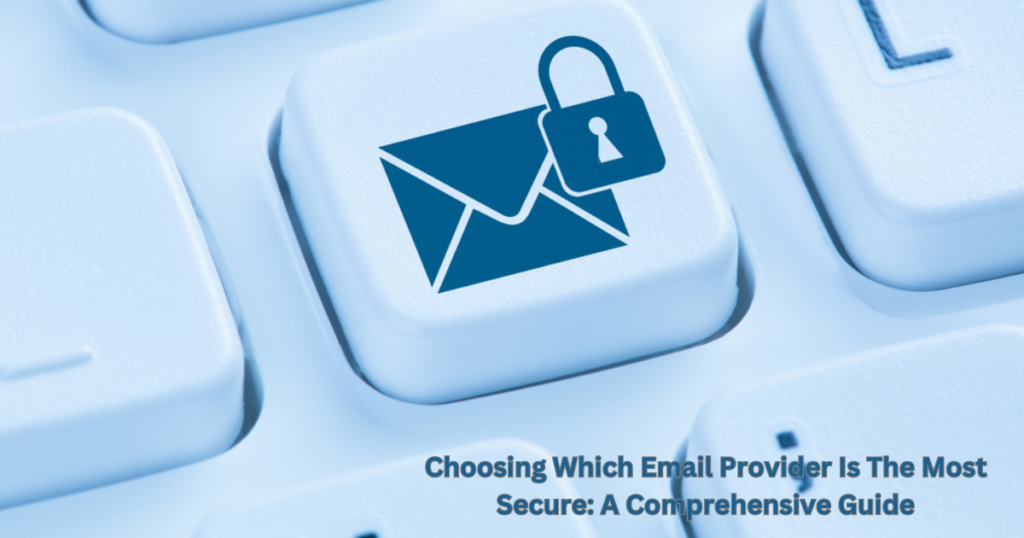Determining the most secure email provider is a crucial quest in an era dominated by digital communication. Users seek a fortress for personal and professional correspondence in the labyrinth of options. The question of “which email provider is the most secure” echoes through the cyber realm, prompting individuals and businesses to scrutinize encryption protocols, two-factor authentication measures, and overall commitment to user privacy. As the digital landscape evolves, this inquiry becomes more pressing than ever, underscoring the importance of choosing a guardian for one’s virtual mailbox. Exploring this question unveils a world where titans like Gmail, business-centric Outlook, privacy champions ProtonMail, and open-source advocate Tutanota compete for the title of the ultimate email fortress. Ultimately, the answer lies in the provider’s reputation and aligning the chosen service with individual security needs, making pursuing the most secure email provider a personalized journey through encryption, authentication, and digital guardianship. For more information on email security, you can explore resources on Google’s Security Blog and
Understanding Email Security
The Basics of Email Encryption
When it comes to securing your communication, encryption is the linchpin. End-to-end encryption is a virtual vault, ensuring only the intended recipient can access your email content. Providers like ProtonMail and Tutanota act as encryption superheroes, safeguarding your messages from unauthorized access.
Two-Factor Authentication (2FA)
Two-factor authentication (2FA) is a crucial sidekick in the ongoing battle against cyber threats. Gmail, Outlook, and iCloud Mail incorporate 2FA as a standard security feature. This additional layer of protection, akin to a virtual bouncer, requires users to verify their identity through a second step, such as a text message or an authentication app.
Comparing Email Providers
Google Gmail – The Titan of Email
With over 1.5 billion users worldwide, Gmail is the undisputed email service titan. Google invests heavily in security measures, employing machine learning algorithms to detect suspicious activities. Gmail also offers advanced phishing protection and confidential mode, allowing users to set expiration dates on sensitive emails. It’s the titan for a reason.
Microsoft Outlook – A Business-Centric Approach
Outlook, part of the Microsoft 365 suite, caters to business professionals. With enterprise-level security features, including Advanced Threat Protection, Outlook prioritizes protecting sensitive corporate data. Integrating Microsoft’s cloud services ensures a seamless and secure email experience.
ProtonMail – Champion of Privacy
ProtonMail boasts end-to-end encryption and is renowned for its commitment to user privacy. Based in Switzerland, the company adheres to strict privacy laws, providing users with an extra layer of assurance. While the free version offers robust security, the paid plans unlock additional features, such as using a custom domain.
Tutanota – Open Source Security
Tutanota takes a unique approach by being an open-source email provider. This means the source code is publicly scrutinized, allowing security experts to identify and address potential vulnerabilities. Tutanota also employs end-to-end encryption and has a solid commitment to privacy.
Step-by-Step Guide: Choosing the Right Provider for You
Assess Your Security Needs
Before delving into the comparison, assess your specific security needs. Are you an individual user concerned about personal privacy, or are you part of a business handling sensitive corporate information? Understanding your requirements will guide your decision-making process.
Evaluate Encryption Practices
Look into the encryption practices of each provider. Consider whether end-to-end encryption is crucial for your communication or if a provider with robust transport layer security (TLS) is sufficient.
Review Two-Factor Authentication Options
Check the Two-Factor Authentication (2FA) options provided by each service. Ensure that your chosen email provider offers 2FA and opt for hardware-based authentication for an added layer of security.
Consider the Provider’s Reputation
Research the reputation of the email providers. Look for historical security breaches and how promptly the providers addressed and communicated such incidents. User reviews and testimonials can provide valuable insights into the real-world experiences of others.
Explore Additional Security Features
Examine additional security features offered by each provider. This may include anti-phishing measures, spam filters, and the ability to set up email aliases. These features can enhance your overall email security.
Making the Informed Decision
After thoroughly considering your security needs and evaluating the features of various providers, make an informed decision. Security is ongoing; regularly updating your password and reviewing your security settings is essential.
Conclusion
In the ever-expanding digital landscape, choosing a secure email provider is a decision that should not be taken lightly. You can navigate the myriad options available by understanding the critical security features and assessing your needs. Whether you opt for the widespread reach of Gmail, the business-centric approach of Outlook, or the privacy-focused solutions of ProtonMail and Tutanota, securing your email communication is an investment in safeguarding your digital life.
Remember, the key to a secure email experience lies in your chosen provider and commitment to good security hygiene. Stay informed, stay vigilant, and empower yourself with the knowledge to keep your digital communication safe and sound. For more information on email security, you can explore resources on Google’s Security Blog and Cybersecurity & Infrastructure Security Agency (CISA).


